The Huawei P8 Lite Review
by Brandon Chester on July 27, 2015 8:00 AM EST- Posted in
- Smartphones
- Huawei
- Mobile
Battery Life
A phone is only good to the user when it's charged, so having sufficient battery life to last throughout the day is of the utmost importance. Due to various factors of both hardware and software, it's impossible to determine how long a device will last based solely on the battery capacity. Even still, a device's battery capacity can provide some degree of insight into how long a device should last when also considering the hardware it has to power. In the case of the P8 Lite, the hardware runs off of an 8.36Wh battery, which is actually smaller than a phone like the 2015 Moto E with a smaller display. This is due to the more limited space afforded by the P8 Lite's 7.7mm thick chassis.
In order to characterize the P8 Lite's battery life in various scenarios I've run it through our standard battery tests. First up is the WiFi web browsing test to test battery life in a more display bound workflow, followed by BaseMark OS II, GFXBench 3.0 to test a GPU heavy workflow, and ending with PCMark which is a fairly balanced test of all components.
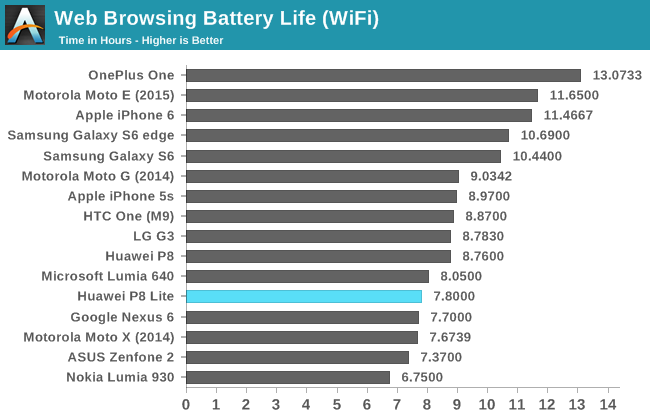
In our WiFi web browsing test the P8 Lite falls somewhat short of the median. It's surrounded by the Lumia 640 and the Google Nexus 6, with the ASUS Zenfone 2 sitting further below it but not by that much. In my view OEMs should really be targeting somewhere around 9 to 10 hours of battery life for web browsing at 200 nits, and at 7.8 hours the P8 Lite doesn't make that mark. What concerns me is that the Zenfone 2 isn't that far behind, and it's both $50 cheaper, significantly faster, and has a much sharper display. Better web browsing battery life definitely would have given the P8 Lite a much needed advantage over the competition.
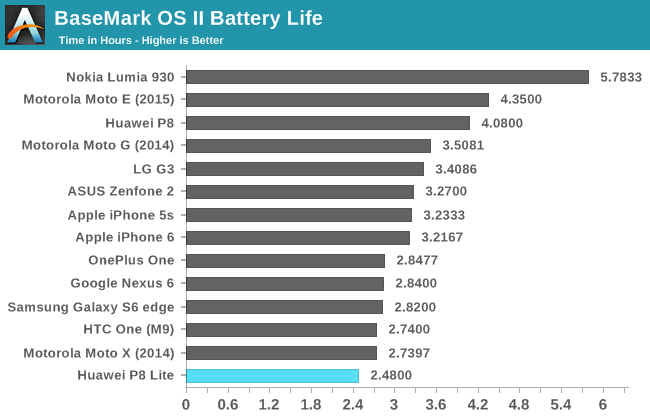
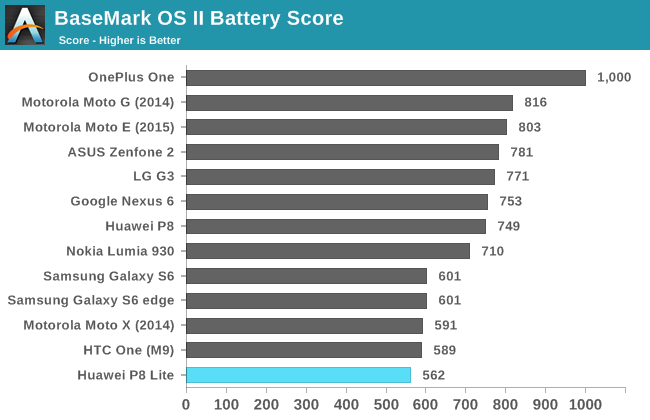
In BaseMark OS II's battery test the P8 Lite does not perform well at all. Not only is the battery life the shortest device on the chart, but sustained performance throughout the test is much lower than many other devices which leads to it also receiving the lowest battery score of our listed devices.
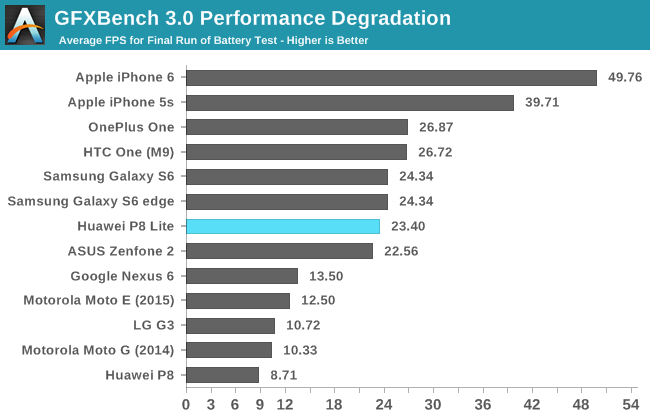
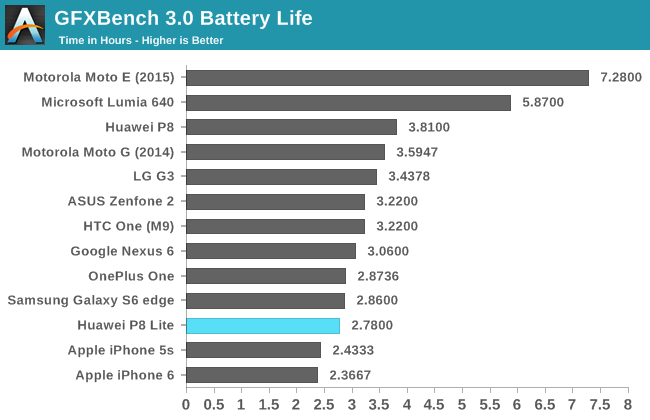
With its smaller battery and much higher sustained performance than devices like the Moto G, Moto E, and Lumia 640, it's not a surprise that the P8 Lite lasts a significantly shorter time in the GFXBench battery life test. However, the result doesn't sit far behind many other devices on the chart, and the P8 Lite achieves similar performance at its native resolution. What I can say about battery life in GPU intensive scenarios on the P8 Lite is that it's decent, and it's not at all unexpected given the device's hardware and battery capacity.
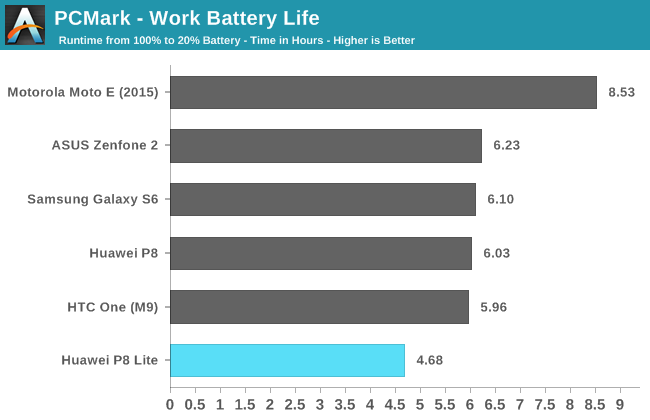
The P8 Lite demonstrates disappointing battery life in PCMark's battery benchmark. This benchmark consists of running through all of PCMark's standard tests in a loop, which gives a good idea of what battery life will be when the phone is subject to various different use cases over a period of time. At 4.68 hours, the P8 Lite falls well behind our other smartphones, and considerably far behind the 2015 Moto E which is a less expensive device.
It's clear from our battery tests that the battery life of the P8 Lite is quite short. This was fairly evident when using the device throughout the day. Something that isn't explicitly shown here is that there appears to be a large amount of battery drain when the device is idle. I often found the battery in need of a charge even during times when the device had only been laying on my desk for the night after minimal use during the day. As far as both active and idle battery life is concerned, the P8 Lite is disappointing.
Charge Time
Charge time isn't often thought of when considering what device to buy, but it can have a substantial impact on the user experience. If a phone lasts a short time and takes a long time to charge then a user can be without a usable device for a much longer period than the battery life alone would imply. On the flip side, a short charge time can improve the experience on a device with shorter than desired battery life by making it quick to get it back to a usable state.

The P8 Lite ships with a 5W charger in the box. Unfortunately, with its stock charger the P8 Lite has the longest charge time of all recent devices. This is a problem when coupled with the P8 Lite's short battery life, as it means the device will run out of power quickly and then take a long time to get back to a 100% charge again.


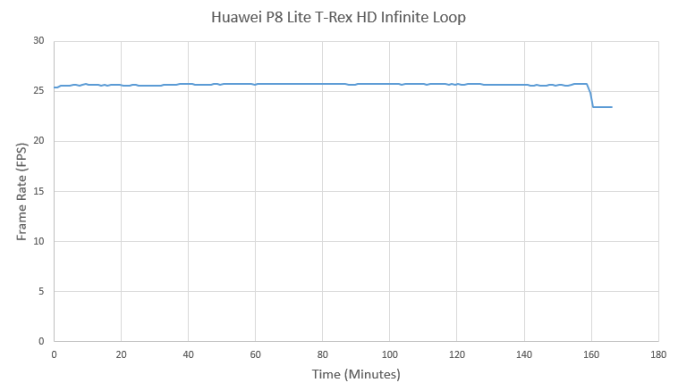








45 Comments
View All Comments
Buk Lau - Wednesday, July 29, 2015 - link
It is capable of QC 2.0, they just don't ship you with a charger and you just have to get it yourself from somewherezebrax2 - Monday, July 27, 2015 - link
Error in the specifications table showing A7 instead of A53.jjj - Monday, July 27, 2015 - link
Disturbing that for a SoC known for it's overheating capabilities (yes this one too), you fully ignore the issue and don't look for throttling."Snapdragon 615 is really the best you're going to get at this price point"
That is clearly a false statement and not sure how can you make it. SD615 is likely the worst A53 based solution in this price range clock for clock and not just in CPU. If you factor in that others are going higher clocks (without overheating) in the same price band and even higher clocks for slightly costlier and more capable SoCs , your statement becomes even more absurd.
But that's when you factor in the SoC price not the device price. If you go by device price, the OnePlus One is 250$ and if you factor in China, a bunch of faster devices are at or very close that price.
T1beriu - Monday, July 27, 2015 - link
Source?jjj - Monday, July 27, 2015 - link
For what? SD615 can't do 1.7GHz and pretty much any device with those clocks is know to have problems. At 1.5GHz it throttles little if at all but that can depend on the device and requires investigation. As for how it does against competing 8xA53 SoCs from Hisilicon (hey those are actually worse), Marvell, Mediatek and Samsung it would take some time(that i don't have) to find a bunch of reasonably good links since too many can't be bothered to look beyond Qualcomm, just like AT loves to do.djw39 - Monday, July 27, 2015 - link
How can you say the Snapdragon 615 is "likely the worst A53 based solution in this price range" then?LiverpoolFC5903 - Tuesday, July 28, 2015 - link
The MTK 6752 is significantly faster than the SD 615 and runs cooler too, despite all the ores being clocked at a relatively high 1.7ghzThe 615 flatters to deceive and is hamstrung by memory bandwith issues and thermals. If they had provided a dual channel 32 bit RAM like the older Snapdragon 600 and paired it with the Adreno 320, it would have been a killer mid range chip. Alas,this is par for the course these days with Qualcom chipsets.
One more observation, the Zenfone 2 is absolutely suberb in terms of performance/price/ Nothing else in the midrange comes close to it in terms of both CPU and GPU performance. The 2.3 GHZ and 4 GB model at 300 USD performs as good as any Snapdragon 801 device and trades blows with the 805.
AndrewJacksonZA - Tuesday, July 28, 2015 - link
Totally off topic, so apologies in advance, but..."T1beriu" as your nick? Is it meant to be in reference to the Tiber River? Tiberius Caesar? Tiberium? Brigadier General Mark Jamison Sheppard must know! :-)
twizzlebizzle22 - Monday, July 27, 2015 - link
What's the benefit of using big little with the same core architecture between the clusters.Can't one cluster scale back under lighter workloads?
cmikeh2 - Monday, July 27, 2015 - link
You can fab the transistors for the two different clusters differently. For the high performance cluster, you would use a higher leakage, faster transistor (and power gate when not in use) and for the low power cluster use slower, but lower leakage transistors.